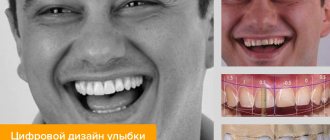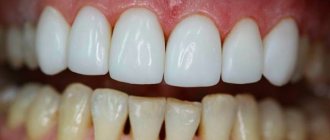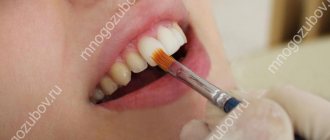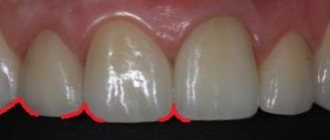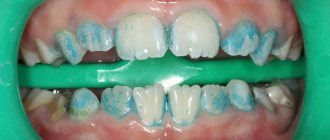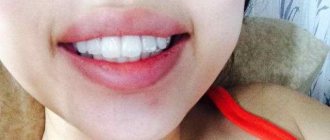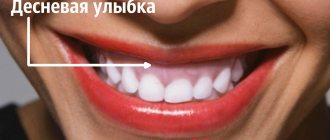Scientists have proven that a smiling person evokes more sympathy than even the most beautiful but gloomy top model. Moreover, employers are more loyal to those with healthy and beautiful teeth. Such people give the impression of being more responsible and efficient. And Dutch researchers claim that with a smile a person always looks younger than his age. How to achieve an ideal smile and what to do if nature has not endowed you with beautiful teeth, says Ilgam Vagifovich Mamedov, leading orthopedist and chief physician of the German Center for Aesthetic Dentistry SDent in Moscow.
How can digital technology help transform your appearance?
Our clinic actively uses Digital Smile Design technology (“digital smile design” or DSD, read as “digital smile design”) in combination with the principles of Dental Face Lifting (“dental facelift”). Based on the capabilities of digital computer modeling, we restore the ratio of the proportions of the face and teeth according to the “golden ratio” principle using orthopedic and orthodontic structures (for restoring teeth with the help of dentures, as well as correcting the bite, respectively).
We recreate the correct anatomy of the teeth, normalize the chewing load, restore youth to the facial contour and get exactly the smile that suits the patient best.
Every person is unique. Therefore, there are no template solutions. The patient’s personal information is loaded into the Digital Smile Design program - his photographs, computed tomography and intraoral scan data. Based on them, the doctor creates a model of the future smile, taking into account all individual anatomical features. And then the models are transferred to the articulator in order to verify the bite relationships and make adjustments if necessary.
Digitally designed veneers transform your smile and look more natural
All the necessary proportions and measurements are included inside the program. She suggests how best to work out the aesthetics and draws up a step-by-step treatment plan.
Making veneers is a multi-stage and expensive procedure; the cost of an error is quite high. Therefore, it is useful for all participants in the process - the patient, the orthopedic surgeon and the dental laboratory specialists - to have the same information, which cannot be interpreted in their own way. It is this consistency that careful planning of the treatment process can achieve.
The DSD program transmits clear data backed up by 3D images to the laboratory. Everything is taken into account: the shape, shade, height and width of future restorations, their exact positioning and relationship with the gum. Distances are adjusted to fractions of a millimeter, and the color of future veneers is selected on a scale taking into account the color of the patient’s eyes and skin.
This means that the risks of the human factor are eliminated. There will be no errors in color perception or distortions in shape. The laboratory, the orthopedic dentist and, of course, the patient will not differ in their expectations of the result.
Ceramic veneers
natural look requires turning Price: from 25,000 rub. Price: from 25,000 rub.
Zirconium veneers
stronger and thinner turning is required Price: from RUB 25,000. Price: from 25,000 rub.
Ceramic composite
light and durable turning is not always required Price: from 15,000 rubles. Price: from 15,000 rub.
Lumineers
the thinnest veneers do not require turning Price: from 65,000 rubles. Price: from 65,000 rub.
We create beautiful smiles! Veneers and lumineers are non-staining and protect teeth. 3D modeling is included in the price!
Free consultation
Which teeth bite is not considered correct?
The presence of deviations from the norm is at least the basis for a dental diagnosis, based on the results of which a decision is made on the need for treatment. The best option is orthodontic correction in childhood, since the dentofacial apparatus, which is in the stage of formation, is more easily amenable to the targeted influence of a special machine and takes on the desired structure without surgical intervention. The most commonly diagnosed abnormal forms have certain signs that allow us to understand whether a person’s bite is correct or not, what is going wrong, and how this deviation can affect the further development of the jaw:
- Distal - diagnosed with excessive development of the upper jaw, noticeably protruding forward and distorting facial features.
- Mesial is a reverse pathological condition in which the mandibular row protrudes, almost completely covering the incisors and canines.
- Cross - characterized by the presence of free areas between the teeth, as well as a “scissor” intersection of elements in a random order.
- Deep - significant, more than 30%, overlap of the lower section.
- Open - contact during closure is observed only between individual chewing units, while in the incisal region there are pronounced gaps, creating the impression of a constantly slightly open mouth.
Any pathological manifestation requires timely medical intervention. Not all patients know what a correct bite in a person is and what it is needed for - but this indicator affects the quality of respiratory and speech function, ensures the conditions for normal food processing and the functioning of the gastrointestinal tract. By contacting Dentika dentistry, you can undergo a comprehensive diagnosis, receive recommendations from qualified specialists and, if necessary, resort to orthodontic correction services.
Signs of a perfect smile
White teeth and healthy gums are not all that define beauty. Sometimes, when looking at a smiling person, we feel dissonance, but we cannot formulate what exactly confuses us. In fact, our brain automatically evaluates the proportions and shade of teeth in combination with the shape of the lips, the height of the face and the color of the skin, and finds inconsistencies.
People intuitively follow the natural law of harmony - the so-called “golden ratio” formula. Everything that obeys this principle looks right, beautiful and young in our eyes.
The doctor’s task is to restore the smile so that all parameters correspond to the canons of natural harmony. Then not only the teeth, but also the person’s appearance will change for the better.
The “golden proportion” is found everywhere - from the structure of flowers to the biorhythms of the human body. And, of course, this law is used in art, exact sciences and aesthetic medicine.
Based on the principle of the “golden ratio,” aesthetic restoration specialists have derived the parameters of a harmonious smile:
- The type of face and the shape of the teeth should be combined. Teeth of different shapes and heights are in harmony with oval, conical or square face types,
- imaginary horizontal facial lines passing under the eyes, under the upper and lower lips should be parallel,
- the level of the visible gum margin should not be too high; ideally, the upper lip should completely cover the gum,
- We take the slight protrusion of the upper incisors from under the lip as a sign of youth when the mouth is slightly open,
- shades of teeth and skin should be combined. Not everyone is suitable for snow-white teeth without an admixture of other natural shades,
- the line of the lower lip and the arc of the incisal edge of the upper teeth should run parallel when smiling,
- the conditional center of the smile should coincide with the vertical line that divides the face in half.
Lip line is an important factor
In addition to teeth, lips also play an important role in a smile. Even with the straightest and whitest teeth, unkempt lips will ruin the whole picture. Lips should be cared for in the same way as facial skin. It is necessary to moisturize and nourish them twice a day, and use a gentle lip scrub once or twice a week. The line and fullness of your lips are highly dependent on your bite, and if you don't like the shape of your lips, chances are you'll need to see an orthodontist to check for any possible malocclusions.
Celebrity Perfect Smiles
Public figures learn to smile the same way they learn to give speeches in public. There are exercises that allow you to develop the facial muscles involved in smiling (and there are more than a dozen of them). Among them are stretching your lips into a tube, exhaling air through it, trying to make a figure eight with this tube, as well as relaxing your lips and trying to stick your tongue out as far as possible. A beautiful smile is practiced in front of a mirror. The corners of the lips should be symmetrical, and only the ten upper teeth should be exposed. When you remember the position of the muscles in front of the mirror, close your eyes and bring the skill to automaticity.
Advantages of computer modeling when designing veneers
- Visibility. Even before the start of any interventions and grinding of teeth, the patient can assess what his smile will look like after veneering.
- Direct participation . The patient sees all smile changes on a tablet or laptop screen. He can make adjustments immediately and be confident that the doctor understands his wishes for appearance and aesthetics.
- Predicted result. Computer technologies and robotics make it possible to make veneers exactly as the patient saw them at the approval stage in the program and when trying on the model. Disappointments are excluded.
- Well-established communication. Digital Smile Design facilitates communication between the orthopedic surgeon and the dental technician, as both rely on the same clear data.
- Speed. Thanks to digital technologies, robotic installation, such as CAD/CAM and 3D printing, you can try on and evaluate your future smile in 2-3 days.
- Process automation. Depending on the software, the finished smile model is uploaded to robotic dental systems. Veneers can be created using high-precision milling equipment.
- Comfort and simplicity. For modeling, you only need photographs and a cast; there is no need to undergo additional and complex diagnostic procedures.
- Aesthetics. The DSD programs are based on the principles of the “golden ratio”, so that any initial situation can be brought to the ideal. At the same time, the functional features of the dental system are taken into account so that beauty does not diverge from health.
We create smiles by working with our souls! Your new teeth will not only be beautiful, but also as comfortable as possible. Free consultation and 3D diagnostics!
Sign up online
Choice number 2: aesthetic braces made of sapphire and ceramics
Those who definitely can’t be embarrassed about photos of smiles with teeth are people who have highly aesthetic braces made of ceramic or artificial sapphire. Snow-white or almost transparent plates look like precious jewelry or a fashion accessory. They are neat, compact, smooth. And if they also come with a white-painted metal arch, the systems become almost invisible in the oral cavity.
Which celebrities have been seen wearing such orthodontic devices? In fact, the list of star patients can be continued endlessly. Here are just a few of them: Cristiano Ronaldo, Regina Todorenko, Timur Rodriguez, Paulina Andreeva, Danya Milokhin, Tom Cruise, Faith Hill, Prince Harry, Fantasia Barrino, Niall Horan, Cristiano Ronaldo, Estelle, Carrie Underwood.
Some people don't even think about being embarrassed about wearing braces.
Are you also thinking about installing aesthetic ceramic braces, but don’t know which one to choose? Especially for you, the editors of the UltraSmile.ru portal have prepared a review of the most popular models.
American actress and fashion model Dakota Fanning also wore them. The girl had serious bite pathologies, so she additionally had to undergo treatment using bulky orthodontic extraoral appliances, which she was not at all embarrassed about. In addition, the young actress loved to emphasize her individuality and the presence of braces in every possible way, choosing multi-colored ligatures to match them.
And Danny Glover installed aesthetic braces at the age of 62, which once again proves that it is never too late and not at all scary to correct your bite and improve your smile. Nobody will judge you for taking care of your health.
Where else is digital smile design used?
Smile planning using digital technology is suitable for everyone who wants to have a harmonious face that is as close as possible to the canons of beauty. There are no contraindications or age restrictions. Therefore, the technology can be used wherever an accurate plan and predictable aesthetic effect of treatment is needed: implantation and prosthetics, the creation of various orthopedic structures, surgical gum surgery and even orthodontic treatment.
In what cases will computer planning procedures help?
- slight disproportion and asymmetry of the face,
- abrasion of enamel and decrease in bite height,
- violations of aesthetics - chips, dark spots, uneven teeth,
- absence of one, part or all teeth,
- age-related changes, wrinkles in the lip area, deepening of nasolabial folds,
- loss of facial muscle tone, drooping soft tissue in the lower third of the face,
- sinking of the cheeks and corners of the lips,
- desire to change the shape and color of teeth.
Digital modeling greatly improves mutual understanding between the prosthodontist, dental technician and patient. As a result, the patient gets exactly the smile he dreamed of.
Choice #1: Lingual Braces
Such structures are completely invisible to others, as they are attached to the inside of the dentition. And this allows you to keep the fact of undergoing treatment a secret, even if you are constantly in public and openly smiling. Although some celebrities do not hide this at all, because today taking care of your health is not only useful, but also fashionable. For example, Victoria Bonya, who decided to correct her bite at the age of 36. The actress and TV presenter openly showed photographs of lingual plates made for her straight from the dentist's office.
Victoria Bonya decided that it’s never too late to change
Singer Vera Brezhneva also wore lingual systems. According to one of the most beautiful women in Ukraine, her wisdom teeth erupted, which disrupted her bite, so she had to take action. True, Vera notes that while adapting to the systems, she experienced slight problems with diction. However, it is important to understand that in the case of devices that are attached to the tongue, this is a completely common phenomenon that gradually goes away a few weeks after installation.
All the pros and cons of lingual systems are in a feature article on the website.
Crowns made from “IPS E.max” –
IPS E.max materials are metal-free lithium disilicate ceramics intended for the manufacture of crowns and veneers. The E.max material is glass-ceramic, the light transmittance/transparency of which is almost identical to natural tooth enamel. Because of this, lithium disilicate crowns and veneers are sometimes completely indistinguishable from real teeth.
There are 2 main E.max materials for making crowns. Firstly, this is “E.max PRESS”, which is designed for the manufacture of crowns and veneers using injection molding at high temperature and pressure. Let's say right away that this material is the best if you want to make single crowns or veneers, or you need a 3-unit bridge on your front teeth.
Secondly, this is “E.max CAD”, intended for the manufacture of crowns and veneers using the milling method (CAD/CAM technology), so the same method is used here as in the manufacture of zirconium crowns. Compared to E.max PRESS, this material already has slightly less strength and is no longer suitable for the manufacture of bridges and thin veneers. Another disadvantage is that E.max CAD has a much smaller range of material shades, which limits the dental technician’s ability to ensure that the crown actually blends in color with the adjacent teeth.
Clinical case No. 8 (before and after photos) –
Take a look at the before and after photos posted above. In this case, the patient used E.max CAD ceramics, although E.max PRESS ceramics has a significantly larger range of material shades (which provides more opportunities to make the crown invisible against the background of neighboring teeth). But in this case, the patient had crowns made for 10 front teeth at once, and therefore the dental technician was not faced with the task of accurately imitating the color and transparency of the neighboring teeth.
From this we can conclude that if you need to make one or more crowns, it is better to choose E.max PRESS ceramics. If you are going to make crowns for all the front teeth (at least one jaw), then “E.max CAD” ceramics are also suitable.
For more information about the various options for manufacturing zirconium crowns and the rating of manufacturers of zirconium dioxide blocks, read the article: → Options for manufacturing E.max crowns, prices
CONCLUSION:
Definitely, my opinion on male veneers is that ceramic veneers are more suitable for men, and not only for men, but also for women and teenagers.
Ceramic veneers
- this is completely different, this is
forever
, their crazy aesthetic appearance is the same as that of natural teeth.
And if you even bother and get exclusive veneers, then this is absolutely FANTASTIC
and the highest step of the pedestal!
Well, the durability of ceramics has not been denied. The cost of ceramic veneers, of course, is higher, but this is another question: either do it or not do it.
Comments
My teeth look quite normal, even. Only a few teeth on the bottom row are out of line. Recently the need arose to place an implant underneath, but the doctor said braces first. Why would I wear such a system for several years just because of 2 crooked teeth?
Zhenya G. (12/21/2021 at 09:13 pm) Reply to comment
- Even a few crooked teeth can become an obstacle to high-quality implantation, as they can disrupt the functionality of the maxillofacial apparatus and contribute to improper distribution of the chewing load. It is also possible that there is not enough space on the jaw to install an implant and denture. Or, after the loss of a tooth, the neighboring ones have moved towards the empty space, and this situation needs to be corrected with braces. Please note that after installation and healing, implants become immobile, while the roots of real teeth can be moved. Accordingly, if problems with the TMJ subsequently arise, if clicks and clamps or other dysfunctions appear, it will no longer be possible to wear braces with implants. Accordingly, the doctor will not be able to be 100% sure of the quality of the work done. Therefore, it is better to correct any bite pathologies, if any, before installing implants. If in doubt, consult several specialists.
Editorial staff of the portal UltraSmile.ru (12/22/2021 at 09:14) Reply to comment
